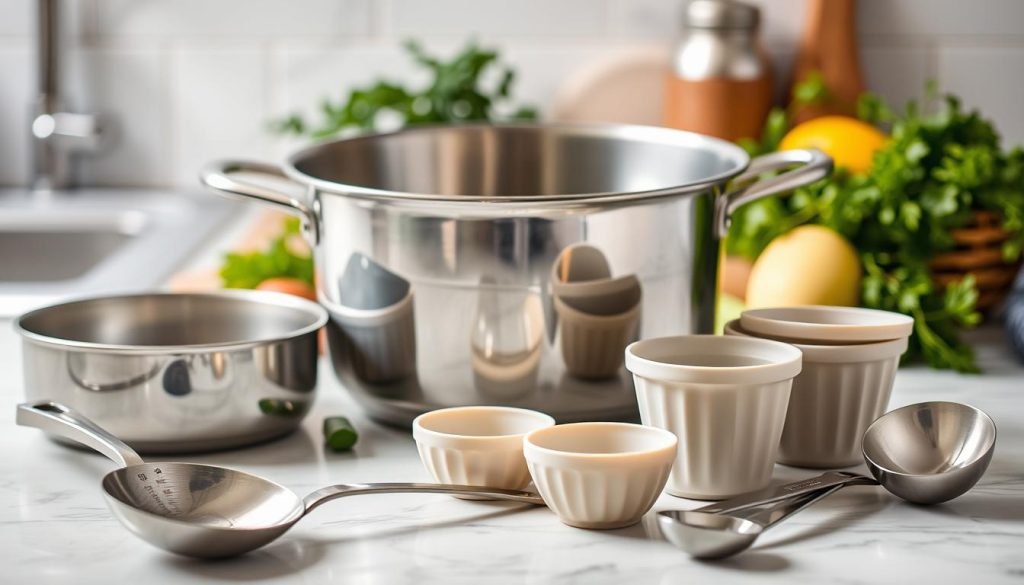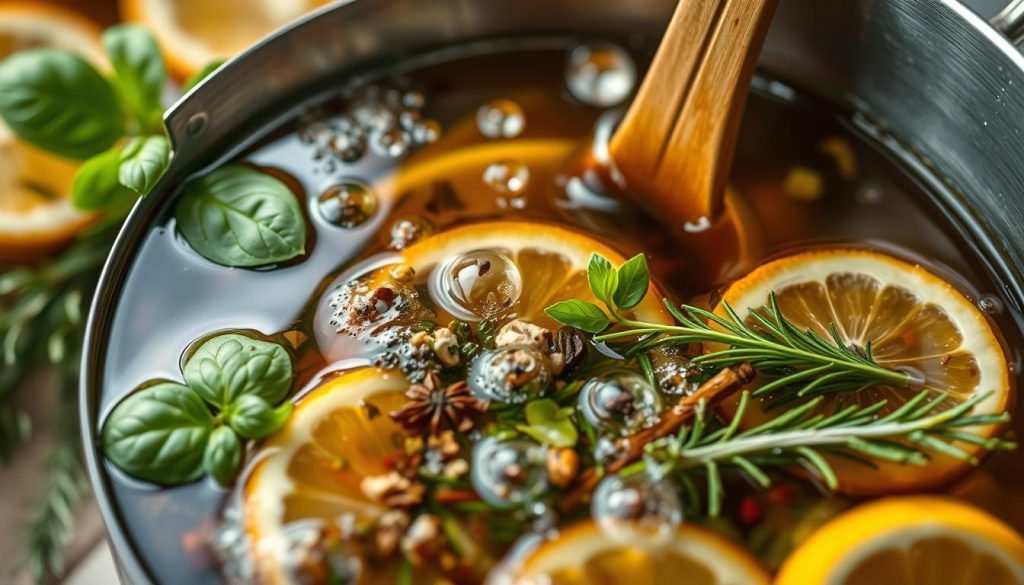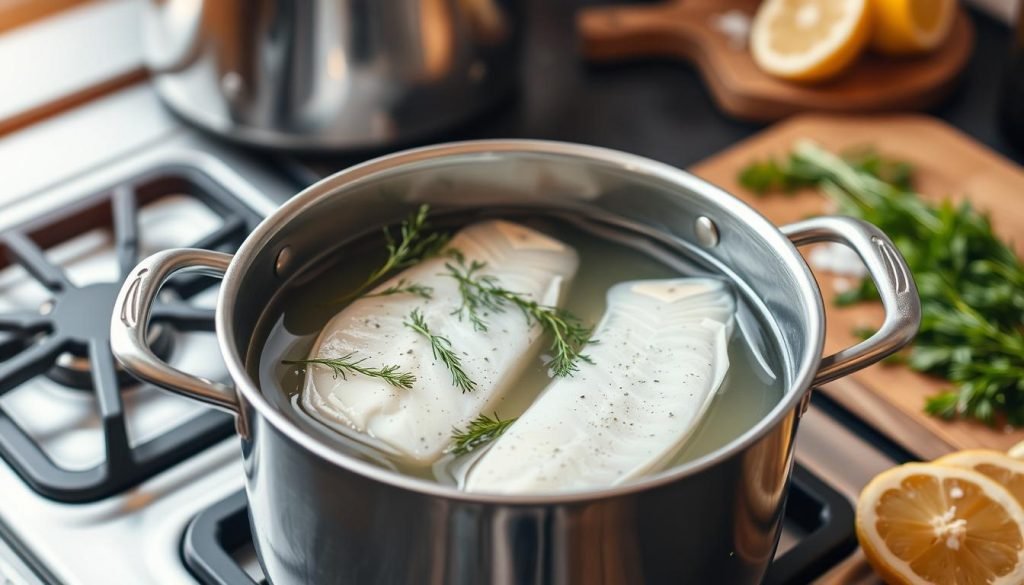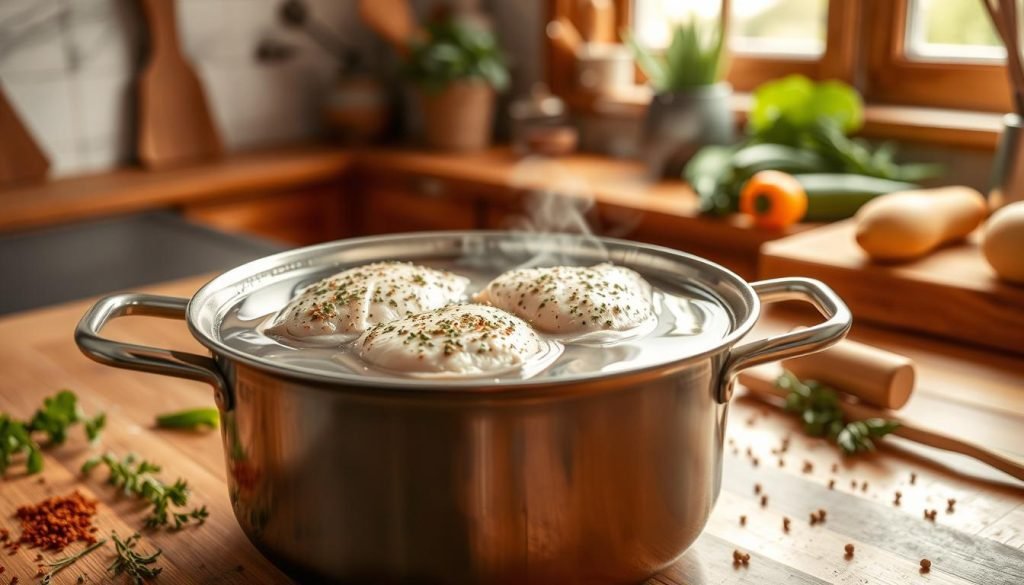Master Poaching: Chef’s Guide

Ever wondered why gourmet dishes taste so delicate and perfect? The secret is in poaching, a favored technique in pro kitchens. By mastering poaching, you turn basic items into awesome meals. This guide shares expert chefs’ tips on poaching different foods.
Key Takeaways
- Poaching is a gentle cooking method essential for fish cookery and requires careful attention to detail.
- Soft-poached eggs can achieve a runny yolk with just 2-3 minutes of cooking.
- A court bouillon made of water and white wine, simmered for 10 minutes, is crucial for optimum poaching flavors.
- Using vinegar in poaching water helps coagulate egg whites more quickly, enhancing their shape.
- Mastering poaching techniques can considerably elevate your culinary skills, making ordinary dishes extraordinary.
Understanding Poaching: The Basics
Poaching is a way to cook food gently in simmering liquid. It makes the food tender and moist. Knowing how to poach well can make your cooking better, whether you’re new or skilled.
What is Poaching?
In cooking, to poach means to cook food in liquid that’s hot but not boiling. Foods like chicken, fish, or fruits are often poached. This method is good for keeping the food’s flavors and moisture. It does not brown the food’s surface.
| Type of Poaching | Description | Temperature Range | Recommended Use |
|---|---|---|---|
| Shallow Poaching | Only part of the food is submerged in the liquid | 160°F (71°C) to 185°F (85°C) | Fish, Chicken Breasts |
| Deep Poaching | Food is completely submerged in the liquid | 160°F (71°C) to 185°F (85°C) | Lean Meat, Poulet |
History of Poaching Techniques
Poaching has been used for centuries in different cultures. It started with cooking delicate meats and fish. In French cuisine, it became a sign of good cooking. Chefs have made poaching better over time to keep flavor and make food tender.
Benefits of Poaching
Poaching is great for keeping foods tasty and nutritious. It cooks food at the perfect temperature so it stays moist. It’s a healthy way to cook because it doesn’t need much fat. It also adds delicious flavors to the food.
You can use poached chicken in many meals, like salads or tacos. Poached fruits are good for fancy desserts.
Learning poaching can really improve your cooking. It adds style and taste to your meals.
Essential Equipment for Poaching
To get good at poaching, you need the right tools. With the best cookware, thermometers, and utensils, you can keep the temperature just right. This protects the texture of soft foods. Here’s what you should have:
Cookware Needed
Choose a wide, shallow pan for poaching. A sauté pan or deep skillet works well. These pans let the liquid flow around the food, cooking it evenly.
Go for stainless steel, ceramic, or non-stick pans to prevent sticking.
| Cookware | Price Range | Recommendation |
|---|---|---|
| Sur La Table Egg Poaching Pan | $60 | Highly durable and effective for precision cooking |
| Dash Deluxe Rapid Egg Cooker | $30 | Compact and versatile for multiple uses |
| OXO Good Grips Silicone Egg Poachers | $12 for 2 | Affordable and compact, ideal for home use |

Thermometers: Why They Matter
Controlling the temperature is key in poaching. A clip-on thermometer helps you keep an eye on it. You want to stay between 160 and 180°F (71 to 82ºC). This gentle heat keeps the moisture in proteins like fish and eggs. So, for exact temperature control, an instant-read or clip-on thermometer is essential.
Strainers and Ladles
Strainers and ladles are very important for poaching. Strainers help you lift food out of the liquid safely, keeping its shape. This is vital for delicate foods like poached eggs. Ladles help you move liquid and solid gently, so nothing breaks. These tools make sure you can move your poached food smoothly, maintaining its soft texture.
Types of Poaching Liquids
The liquid you choose for poaching really changes the dish’s taste and texture. You can use simple water, tasty broths, or wines full of aroma. Each option brings different flavors and chances to make the dish special.
Water vs. Broth
Water is easy to use but might not add much taste. Using broths, like chicken or beef, adds a yummy savory flavor. These broths get their taste from simmering bones and veggies, making them richer than water.

| Poaching Liquid | Flavor Profile | Uses |
|---|---|---|
| Water | Neutral | Suitable for delicate dishes like poached eggs. |
| Broth | Rich and savory | Best for poultry, red meat, and vegetables requiring depth of flavor. |
Wine and Aromatic Poaching
Wine adds complex flavors to food. When you add things like leeks, herbs, and spices, it gets even better. Poaching with wine is great for giving fish or fruits like apples an elegant taste.
Infused Liquids and Their Uses
Infused liquids make poaching even more exciting. Simmering herbs and spices in oils or coconut milk creates rich flavors. For example, a herb-infused court-bouillon is awesome for seafood. And coconut milk is great for chicken and fish.
Knowing different poaching liquids can make cooking fun and tasty. You can stick with water or try broths, wine, or infused liquids. This knowledge will make your poached dishes much better.
Techniques for Perfectly Poached Eggs

To make great poached eggs, you need to know a few things. You’ll need the right skills and some practice. By following tips from top chefs, like Gordon Ramsay, your breakfasts will become amazing. Let’s learn how to pick the best egg, poach it properly, and avoid mistakes.
Choosing the Right Egg
Fresh eggs are key for poaching; they stay together and look nice because they are less runny. The best eggs have a lot of thick white stuff, about 60%. This helps them keep a round shape when cooked. Older eggs spread out more and get thin edges.
Step-by-Step Egg Poaching
It’s important to follow certain steps when poaching eggs:
- Fill a pot with water, about 4 inches deep, and heat till it nearly boils.
- Put one tablespoon of vinegar in the water. This keeps the egg white together.
- Use a sieve to take away the runny whites, which makes the edges less wispy.
- Stir the water to make a whirlpool, then gently put the eggs in the middle.
- Cook the eggs for 3 to 4 minutes until the whites are set.
- Take the eggs out with a spoon with holes and put them in ice water. They can stay like this for two days.
- To reheat, put the eggs in warm water (about 140°F) for 20-30 seconds.
By following these steps from Gordon Ramsay, your poached eggs will come out perfect every time.
Common Egg Poaching Mistakes
- Don’t use old eggs: Always use fresh ones to stop them from spreading too much.
- Make sure the water is deep enough, at least 4 inches.
- Don’t forget the vinegar: It helps the egg hold its shape.
- Start with one or two eggs to get good at it before doing more.
- Removing thin whites with a sieve is a must to avoid failure.
Avoiding these mistakes and using the right methods means you can make poached eggs like a pro. Here’s a quick guide with steps and tips for the best poached eggs:
| Step | Details | Statistics |
|---|---|---|
| Egg Selection | Choose fresh eggs to keep their shape | 60% thick white, decreases with age |
| Water Depth | Water should be at least 4 inches deep | 4 inches recommended |
| Vinegar Addition | Add 1 tablespoon of vinegar to water | 1 tablespoon per pot |
| Cooking Time | Cook eggs for 3 to 4 minutes | 3 minutes is best |
| Storage | Put them in ice water in the fridge | Can be kept for 2 days |
| Reheating | Warm them in water for 20-30 seconds | 140°F is just right |
Use advice from famous chefs like Gordon Ramsay to poach eggs the best way. With practice and by following these tips, you’ll get good at making poached eggs.
Poaching Fish: Tips and Tricks

Poaching fish makes it tender and full of flavor. It’s a top way to cook many fish dishes. Follow these tips and tricks to make your seafood taste great and cook just right.
Selecting Fresh Fish
Always choose the freshest fish you can find. Look for fish with clear eyes and shiny skin. The flesh should feel firm and spring back when pressed. This applies whether you’re cooking a soft cod fillet or a thick tuna steak. Your fish will taste better and keep a good texture.
Poaching Temperatures and Timings
The right temperature and time are crucial for poaching fish. Aim for 140 to 160 degrees Fahrenheit. Here’s what you might need:
- A cod fillet needs about 7 minutes in broth.
- A buttery tuna steak cooks in about 10 minutes.
- Fish is done at around 135 degrees Fahrenheit.
Remember, cooking times depend on the thickness and type of fish. Don’t put too many pieces in the pan at once. This can cool the liquid and increase cooking times.
Flavoring Fish with Aromatics
Aromatics enhance the fish’s flavor. Use a light broth or court bouillon for healthy and tasty cooking. Let the court bouillon simmer for 10 minutes before adding your fish.
Seasoning tips:
- Season fish 5 to 10 minutes before cooking to let it warm up a bit.
- Poaching in butter adds flavor and might reduce the need for sauces.
- Cut fish into 5- to 6-ounce pieces for even cooking.
- Use a medium-salt broth for a well-rounded taste.
| Fish Type | Poaching Liquid | Cooking Time (minutes) |
|---|---|---|
| Cod Fillet | Broth | 7 |
| Tuna Steak | Butter | 10 |
| Various Fish Fillets | Court Bouillon | 6 followed by 1-2 resting |
With these poaching tips, you can make your seafood dishes delicious. They will have the gourmet quality and the tender texture that impresses everyone.
Poultry Poaching: Chicken and Beyond
Poaching is a gentle way to cook poultry, keeping it moist and tender. By learning to poach chicken and trying other birds, you can become a pro at healthy meals.

Poaching Chicken Breasts
Poaching chicken breasts is best done at 175 to 180°F. The inside should reach 155°F to stay juicy. The FDA says keeping chicken at 155°F for 50 seconds kills bad germs. Avoid overcooking to prevent it from becoming dry and tough; 165°F is perfect for tender, tasty chicken.
Use smaller chicken breasts, 6 to 8 ounces, for uniform cooking. Flatten them to about 3/4 inch. They usually take 10 minutes to cook. Then, let them sit in the hot liquid for 15 more minutes.
Other Poultry Options
There’s more to poach than just chicken. Try capon, poussin, and duck for different tastes and textures. Capons and duck are great for special meals, offering a fuller flavor. Cooking times can change depending on the bird:
- Capon: Needs more time to poach because it’s bigger.
- Poussin: Cooks quickly, so watch the clock.
- Duck: Poach in flavored broth with spices for best taste.
Alternative Seasonings for Poultry
Change up your poaching liquid with different seasonings. Besides classic court-bouillon, try wine, olive oil, coconut milk, or butter for new flavors. For brining, mix four quarts of water, 3/4 cup kosher salt, and 1/2 cup soy sauce. Add more spices to make it interesting.
| Seasoning | Ingredient Suggestions | Flavor Profile |
|---|---|---|
| Wine | Red or white wine, onions, carrots | Rich, aromatic |
| Olive Oil | Garlic, rosemary, lemon | Fruity, herbaceous |
| Coconut Milk | Ginger, lemongrass, chili | Exotic, creamy |
Mix these ingredients in your poaching liquid for diverse and healthy recipes. This adds new flavors to your meals, making them exciting.
Poaching Vegetables: A Gentle Method
Poaching is a wonderful way to cook vegetables. It keeps their true taste and good stuff inside. This method cooks them with a gentle heat. It’s perfect for soft veggies.

Best Vegetables for Poaching
Many veggies are great for poaching, but some stars include:
- Artichokes
- Asparagus
- Leeks
- Carrots
- Fennel
These veggies keep their shape and bright color. They’re healthy, look good, and taste great.
Cooking Times for Different Veggies
How long to cook veggies depends on what kind and how big they are. Here’s a quick guide:
| Vegetable | Cooking Time |
|---|---|
| Artichokes | 25-30 minutes |
| Asparagus | 3-5 minutes |
| Leeks | 15-20 minutes |
| Carrots | 6-8 minutes |
| Fennel | 10-12 minutes |
Watching the veggies closely is key. Overcooking them makes them mushy and less nutritious.
Enhancing Veggie Flavors
You can add taste to poached veggies easily. Use things like water, wine, or veggie broth. You can also use veggie milks for poaching. Adding tasty things like:
- Bay leaves
- Thyme
- Parsley
- Garlic
- Lemon slices
These add-ons make your dishes taste even better. They turn them into a great eating adventure.
With these hints, you can get really good at poaching veggies. You’ll make amazing, healthy foods that wow everyone.
Creative Poaching Recipes
Want to try gourmet recipes that are fun to make? Check out these amazing recipes that are full of flavor and look beautiful, too.
Poached Pears with Honey Sauce
This dessert is a mix of sweet and spicy. Poached pears with honey sauce taste amazing. They are cooked with vanilla and cinnamon for a soft feel but keep their shape. The honey sauce makes them sweet and perfect for fancy meals.

Poached Salmon with Dill Cream Sauce
This dish has poached salmon with a creamy dill sauce. It’s light but will fill you up. The salmon is tender and moist. A dill sauce with herbs and lemon makes it taste even better. This dish shows how simple cooking can still be fancy.
Spiced Poached Chicken Salad
Try this spiced poached chicken salad for something tasty and healthy. The chicken is cooked with spices making it really flavorful. With greens, oranges, and a zesty dressing, it’s perfect for any meal. It’s a dish that’s both simple and fancy.
| Recipe | Main Ingredient | Flavor Enhancers | Serving Suggestions |
|---|---|---|---|
| Poached Pears with Honey Sauce | Pears | Vanilla, Cinnamon, Honey | Dessert, with whipped cream |
| Poached Salmon with Dill Cream Sauce | Salmon | Dill, Lemon, Cream | Main course, with steamed vegetables |
| Spiced Poached Chicken Salad | Chicken Breast | Spices, Citrus Vinaigrette | Salad, with fresh greens |
These recipes will make your cooking even more fun. Each one uses poaching to bring out the best in the food. Poaching is a great way to cook that you’ll love using.
Common Poaching Mistakes to Avoid
Even the most skilled chefs can make errors while poaching. It’s crucial to use the right technique for great outcomes. Let’s look at the common errors and some tips to dodge them.
Overcrowding the Pan
Putting too much in the pan messes up cooking evenly. If the pan is too full, the heat drops and poaching gets hard. Make sure everything has room to cook right and keep the liquid deep enough.

Incorrect Temperature Control
Keeping the right temperature is key in poaching. It should be cooler than boiling, between 160°F-180°F. If it’s too hot, food gets tough. A good thermometer helps keep the heat perfect for moist, tender results. Below are some ideal temperatures:
| Food Item | Optimal Temperature |
|---|---|
| Eggs | 170°F (77°C) |
| Fish | 165-175°F (74-79°C) |
| Poultry | 175-185°F (79-85°C) |
Not Using Enough Flavor
Poaching in water alone can make food tasteless. To improve, add broth, wine, or spices to your liquid. A court bouillon with 3-5 flavorings can make a huge difference. Try using different stocks to make your dishes stand out.
Mastering Advanced Poaching Techniques
Improving your poaching skills can turn a simple meal into a gourmet experience. Advanced techniques let you cook in new ways. This part talks about sous vide versus traditional poaching, using poaching rings, and poaching in foil pouches.
Sous Vide vs. Traditional Poaching
Sous vide is a top cooking technique for precise temperature control. This method cooks food evenly, making dishes moist and tender. On the other hand, traditional poaching is faster and flavors the food directly in the liquid.
Using a Poaching Ring for Presentation
A poaching ring helps keep poached items—the eggs especially—in a neat shape. It’s great for dishes that need to look good. Just use the ring in the liquid and add the egg. The rings should be well-oiled to prevent sticking.
Poaching in Foil Pouches
Poaching in foil pouches keeps flavors in and controls moisture. It’s great for cooking things like fish or chicken gently. By using a pouch with seasonings and some liquid, flavors are intensified, making the dish rich and savory. This method really makes your food stand out.